Auditing and Assurance: Case Studies of Advanced Computing Solution Limited and Green Machine Ltd
VerifiedAdded on 2023/04/22
|13
|3368
|275
AI Summary
This document provides case studies of Advanced Computing Solution Limited and Green Machine Ltd in the context of auditing and assurance. It includes identification and explanation of key assertions with regard to inventory and PP&E, substantive audit procedures, and communicating key audit matters in the auditor’s report as per ASA 701.
Contribute Materials
Your contribution can guide someone’s learning journey. Share your
documents today.
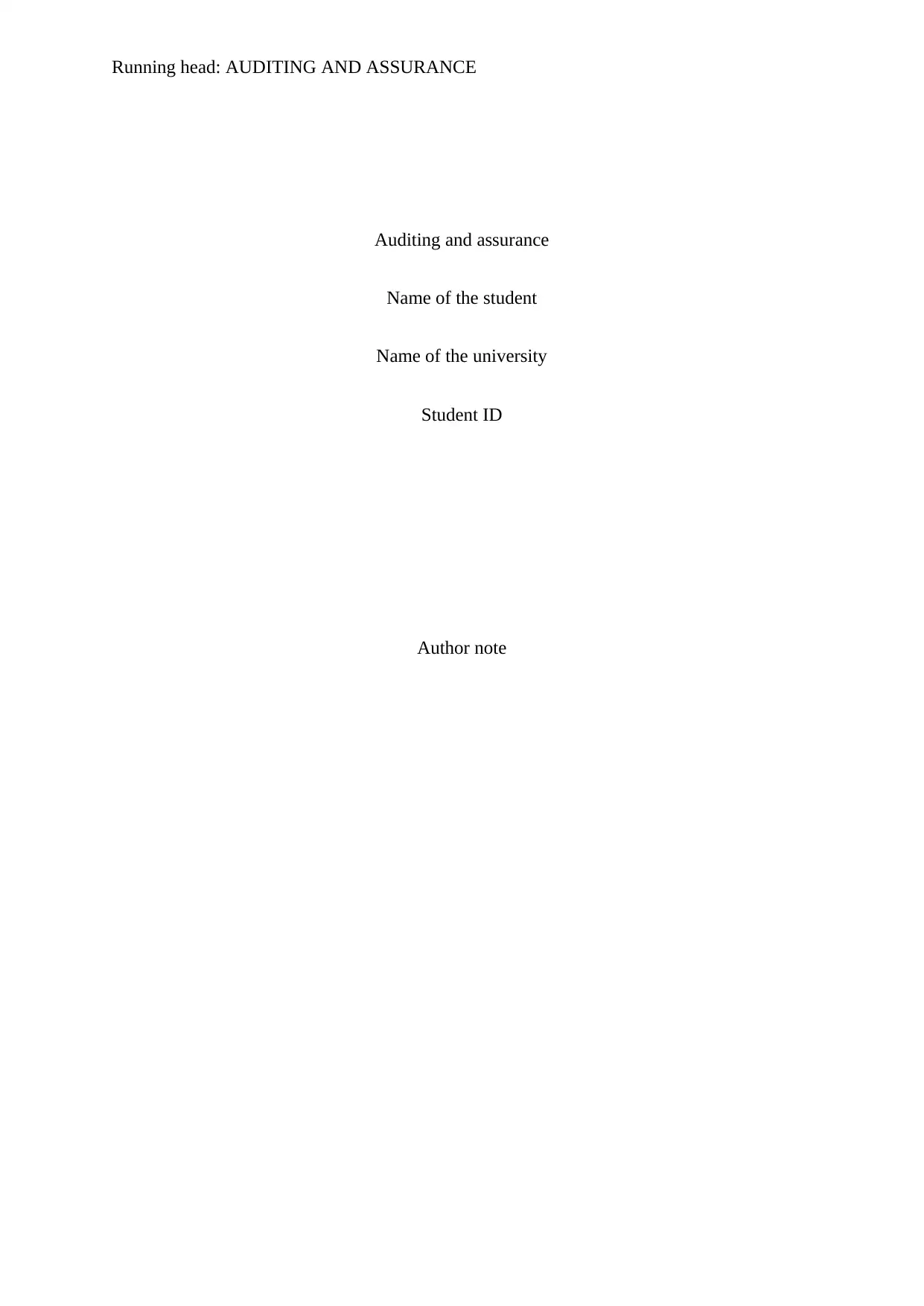
Running head: AUDITING AND ASSURANCE
Auditing and assurance
Name of the student
Name of the university
Student ID
Author note
Auditing and assurance
Name of the student
Name of the university
Student ID
Author note
Secure Best Marks with AI Grader
Need help grading? Try our AI Grader for instant feedback on your assignments.
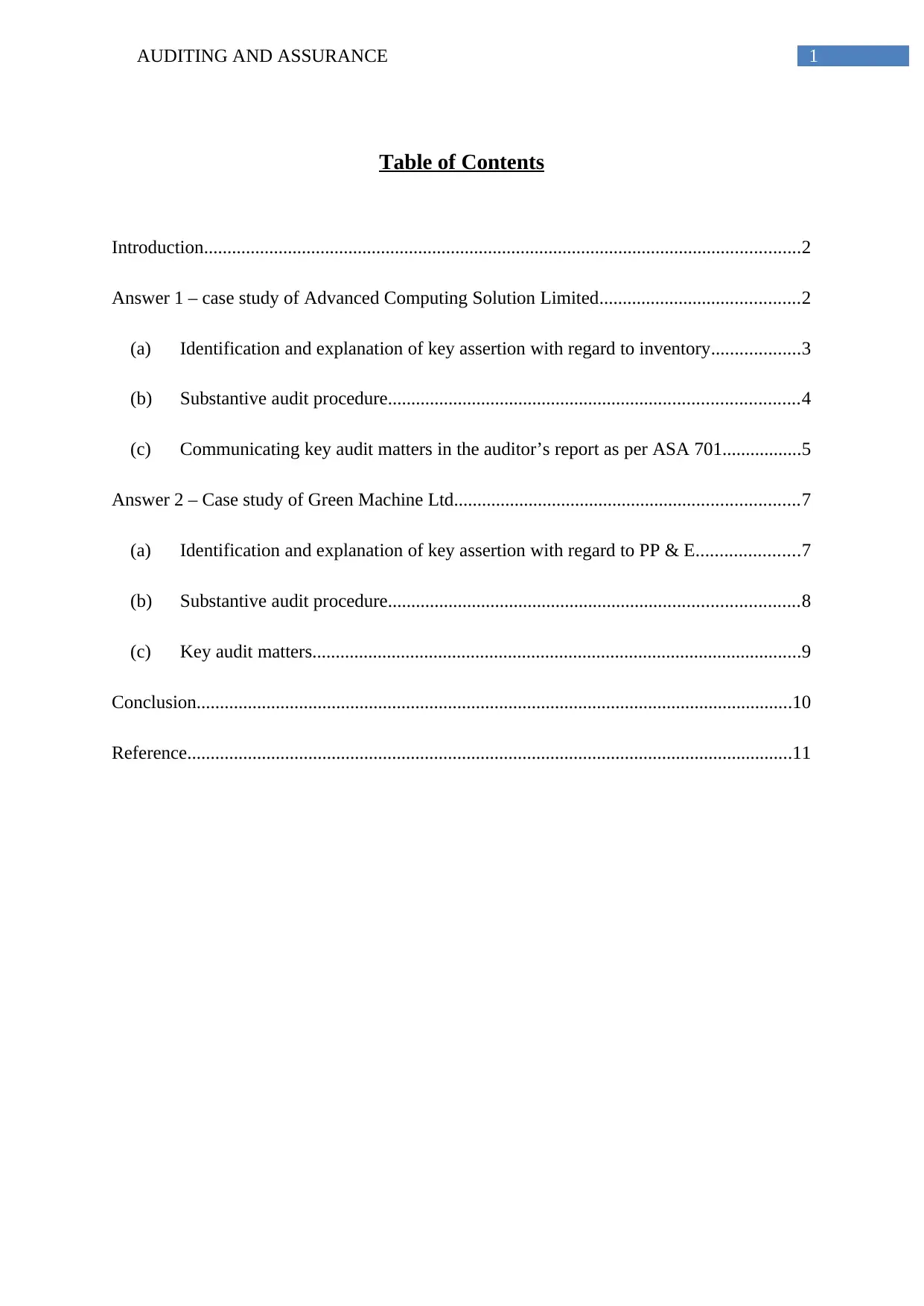
1AUDITING AND ASSURANCE
Table of Contents
Introduction................................................................................................................................2
Answer 1 – case study of Advanced Computing Solution Limited...........................................2
(a) Identification and explanation of key assertion with regard to inventory...................3
(b) Substantive audit procedure........................................................................................4
(c) Communicating key audit matters in the auditor’s report as per ASA 701.................5
Answer 2 – Case study of Green Machine Ltd..........................................................................7
(a) Identification and explanation of key assertion with regard to PP & E......................7
(b) Substantive audit procedure........................................................................................8
(c) Key audit matters.........................................................................................................9
Conclusion................................................................................................................................10
Reference..................................................................................................................................11
Table of Contents
Introduction................................................................................................................................2
Answer 1 – case study of Advanced Computing Solution Limited...........................................2
(a) Identification and explanation of key assertion with regard to inventory...................3
(b) Substantive audit procedure........................................................................................4
(c) Communicating key audit matters in the auditor’s report as per ASA 701.................5
Answer 2 – Case study of Green Machine Ltd..........................................................................7
(a) Identification and explanation of key assertion with regard to PP & E......................7
(b) Substantive audit procedure........................................................................................8
(c) Key audit matters.........................................................................................................9
Conclusion................................................................................................................................10
Reference..................................................................................................................................11
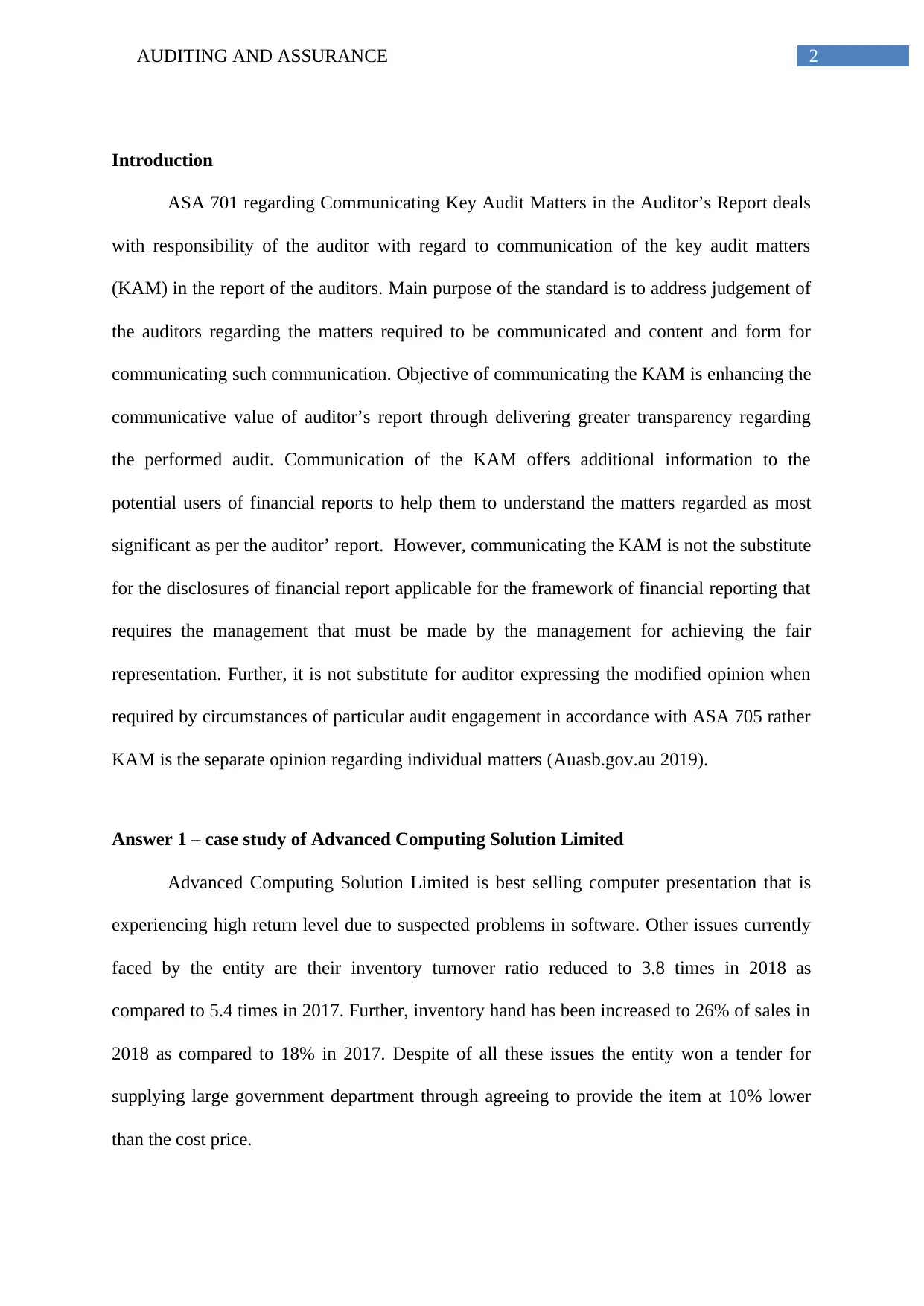
2AUDITING AND ASSURANCE
Introduction
ASA 701 regarding Communicating Key Audit Matters in the Auditor’s Report deals
with responsibility of the auditor with regard to communication of the key audit matters
(KAM) in the report of the auditors. Main purpose of the standard is to address judgement of
the auditors regarding the matters required to be communicated and content and form for
communicating such communication. Objective of communicating the KAM is enhancing the
communicative value of auditor’s report through delivering greater transparency regarding
the performed audit. Communication of the KAM offers additional information to the
potential users of financial reports to help them to understand the matters regarded as most
significant as per the auditor’ report. However, communicating the KAM is not the substitute
for the disclosures of financial report applicable for the framework of financial reporting that
requires the management that must be made by the management for achieving the fair
representation. Further, it is not substitute for auditor expressing the modified opinion when
required by circumstances of particular audit engagement in accordance with ASA 705 rather
KAM is the separate opinion regarding individual matters (Auasb.gov.au 2019).
Answer 1 – case study of Advanced Computing Solution Limited
Advanced Computing Solution Limited is best selling computer presentation that is
experiencing high return level due to suspected problems in software. Other issues currently
faced by the entity are their inventory turnover ratio reduced to 3.8 times in 2018 as
compared to 5.4 times in 2017. Further, inventory hand has been increased to 26% of sales in
2018 as compared to 18% in 2017. Despite of all these issues the entity won a tender for
supplying large government department through agreeing to provide the item at 10% lower
than the cost price.
Introduction
ASA 701 regarding Communicating Key Audit Matters in the Auditor’s Report deals
with responsibility of the auditor with regard to communication of the key audit matters
(KAM) in the report of the auditors. Main purpose of the standard is to address judgement of
the auditors regarding the matters required to be communicated and content and form for
communicating such communication. Objective of communicating the KAM is enhancing the
communicative value of auditor’s report through delivering greater transparency regarding
the performed audit. Communication of the KAM offers additional information to the
potential users of financial reports to help them to understand the matters regarded as most
significant as per the auditor’ report. However, communicating the KAM is not the substitute
for the disclosures of financial report applicable for the framework of financial reporting that
requires the management that must be made by the management for achieving the fair
representation. Further, it is not substitute for auditor expressing the modified opinion when
required by circumstances of particular audit engagement in accordance with ASA 705 rather
KAM is the separate opinion regarding individual matters (Auasb.gov.au 2019).
Answer 1 – case study of Advanced Computing Solution Limited
Advanced Computing Solution Limited is best selling computer presentation that is
experiencing high return level due to suspected problems in software. Other issues currently
faced by the entity are their inventory turnover ratio reduced to 3.8 times in 2018 as
compared to 5.4 times in 2017. Further, inventory hand has been increased to 26% of sales in
2018 as compared to 18% in 2017. Despite of all these issues the entity won a tender for
supplying large government department through agreeing to provide the item at 10% lower
than the cost price.
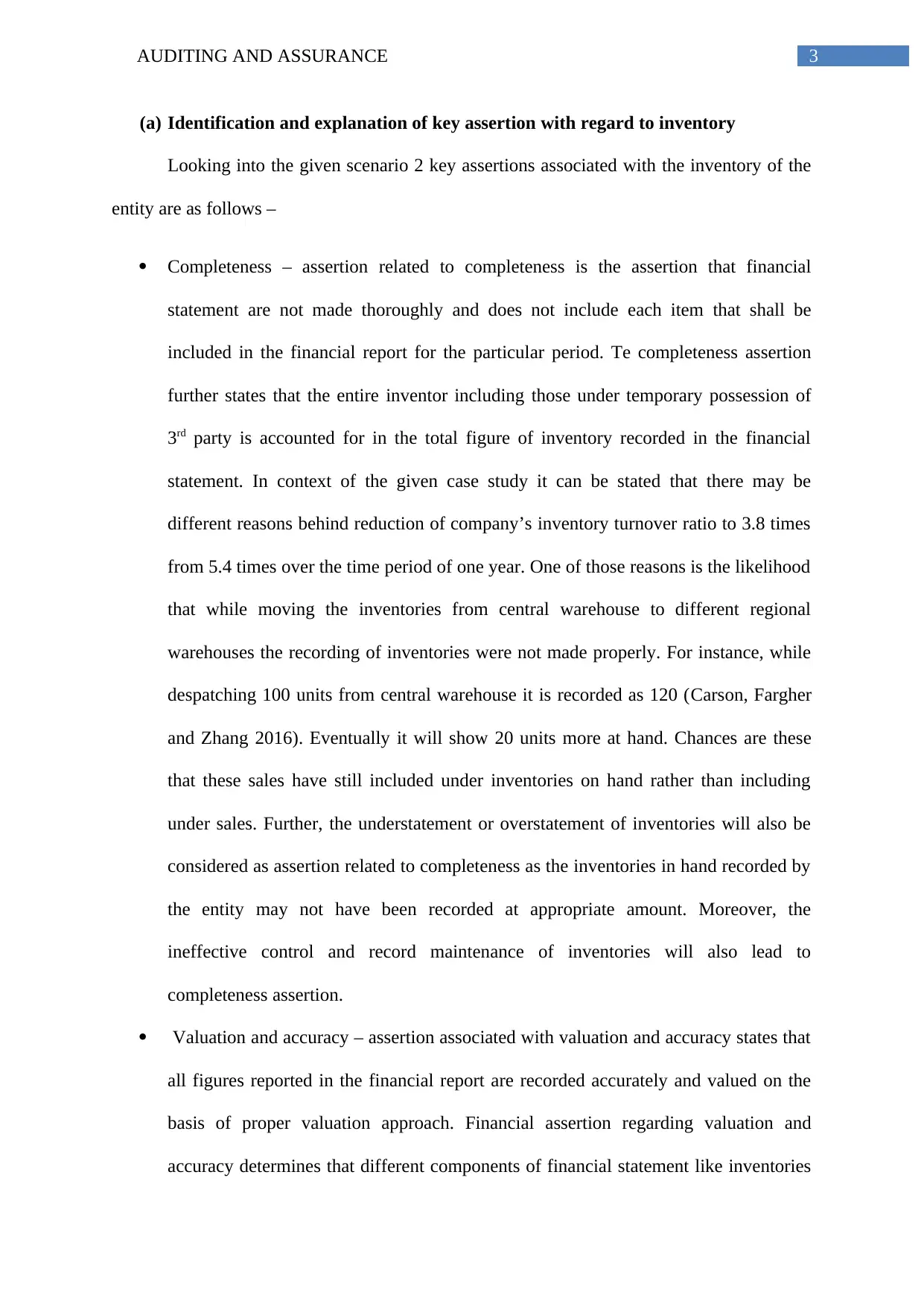
3AUDITING AND ASSURANCE
(a) Identification and explanation of key assertion with regard to inventory
Looking into the given scenario 2 key assertions associated with the inventory of the
entity are as follows –
Completeness – assertion related to completeness is the assertion that financial
statement are not made thoroughly and does not include each item that shall be
included in the financial report for the particular period. Te completeness assertion
further states that the entire inventor including those under temporary possession of
3rd party is accounted for in the total figure of inventory recorded in the financial
statement. In context of the given case study it can be stated that there may be
different reasons behind reduction of company’s inventory turnover ratio to 3.8 times
from 5.4 times over the time period of one year. One of those reasons is the likelihood
that while moving the inventories from central warehouse to different regional
warehouses the recording of inventories were not made properly. For instance, while
despatching 100 units from central warehouse it is recorded as 120 (Carson, Fargher
and Zhang 2016). Eventually it will show 20 units more at hand. Chances are these
that these sales have still included under inventories on hand rather than including
under sales. Further, the understatement or overstatement of inventories will also be
considered as assertion related to completeness as the inventories in hand recorded by
the entity may not have been recorded at appropriate amount. Moreover, the
ineffective control and record maintenance of inventories will also lead to
completeness assertion.
Valuation and accuracy – assertion associated with valuation and accuracy states that
all figures reported in the financial report are recorded accurately and valued on the
basis of proper valuation approach. Financial assertion regarding valuation and
accuracy determines that different components of financial statement like inventories
(a) Identification and explanation of key assertion with regard to inventory
Looking into the given scenario 2 key assertions associated with the inventory of the
entity are as follows –
Completeness – assertion related to completeness is the assertion that financial
statement are not made thoroughly and does not include each item that shall be
included in the financial report for the particular period. Te completeness assertion
further states that the entire inventor including those under temporary possession of
3rd party is accounted for in the total figure of inventory recorded in the financial
statement. In context of the given case study it can be stated that there may be
different reasons behind reduction of company’s inventory turnover ratio to 3.8 times
from 5.4 times over the time period of one year. One of those reasons is the likelihood
that while moving the inventories from central warehouse to different regional
warehouses the recording of inventories were not made properly. For instance, while
despatching 100 units from central warehouse it is recorded as 120 (Carson, Fargher
and Zhang 2016). Eventually it will show 20 units more at hand. Chances are these
that these sales have still included under inventories on hand rather than including
under sales. Further, the understatement or overstatement of inventories will also be
considered as assertion related to completeness as the inventories in hand recorded by
the entity may not have been recorded at appropriate amount. Moreover, the
ineffective control and record maintenance of inventories will also lead to
completeness assertion.
Valuation and accuracy – assertion associated with valuation and accuracy states that
all figures reported in the financial report are recorded accurately and valued on the
basis of proper valuation approach. Financial assertion regarding valuation and
accuracy determines that different components of financial statement like inventories
Secure Best Marks with AI Grader
Need help grading? Try our AI Grader for instant feedback on your assignments.
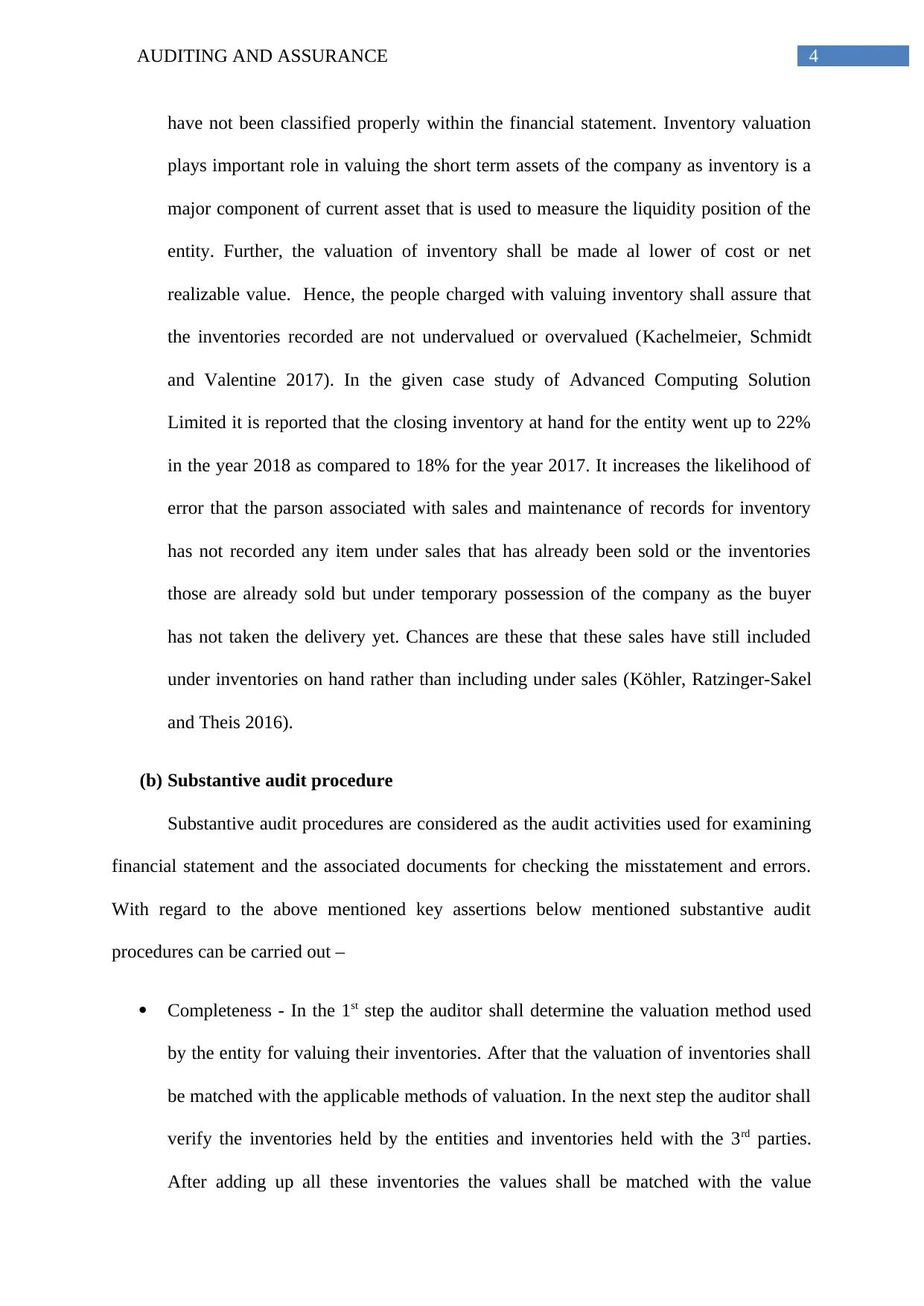
4AUDITING AND ASSURANCE
have not been classified properly within the financial statement. Inventory valuation
plays important role in valuing the short term assets of the company as inventory is a
major component of current asset that is used to measure the liquidity position of the
entity. Further, the valuation of inventory shall be made al lower of cost or net
realizable value. Hence, the people charged with valuing inventory shall assure that
the inventories recorded are not undervalued or overvalued (Kachelmeier, Schmidt
and Valentine 2017). In the given case study of Advanced Computing Solution
Limited it is reported that the closing inventory at hand for the entity went up to 22%
in the year 2018 as compared to 18% for the year 2017. It increases the likelihood of
error that the parson associated with sales and maintenance of records for inventory
has not recorded any item under sales that has already been sold or the inventories
those are already sold but under temporary possession of the company as the buyer
has not taken the delivery yet. Chances are these that these sales have still included
under inventories on hand rather than including under sales (Köhler, Ratzinger-Sakel
and Theis 2016).
(b) Substantive audit procedure
Substantive audit procedures are considered as the audit activities used for examining
financial statement and the associated documents for checking the misstatement and errors.
With regard to the above mentioned key assertions below mentioned substantive audit
procedures can be carried out –
Completeness - In the 1st step the auditor shall determine the valuation method used
by the entity for valuing their inventories. After that the valuation of inventories shall
be matched with the applicable methods of valuation. In the next step the auditor shall
verify the inventories held by the entities and inventories held with the 3rd parties.
After adding up all these inventories the values shall be matched with the value
have not been classified properly within the financial statement. Inventory valuation
plays important role in valuing the short term assets of the company as inventory is a
major component of current asset that is used to measure the liquidity position of the
entity. Further, the valuation of inventory shall be made al lower of cost or net
realizable value. Hence, the people charged with valuing inventory shall assure that
the inventories recorded are not undervalued or overvalued (Kachelmeier, Schmidt
and Valentine 2017). In the given case study of Advanced Computing Solution
Limited it is reported that the closing inventory at hand for the entity went up to 22%
in the year 2018 as compared to 18% for the year 2017. It increases the likelihood of
error that the parson associated with sales and maintenance of records for inventory
has not recorded any item under sales that has already been sold or the inventories
those are already sold but under temporary possession of the company as the buyer
has not taken the delivery yet. Chances are these that these sales have still included
under inventories on hand rather than including under sales (Köhler, Ratzinger-Sakel
and Theis 2016).
(b) Substantive audit procedure
Substantive audit procedures are considered as the audit activities used for examining
financial statement and the associated documents for checking the misstatement and errors.
With regard to the above mentioned key assertions below mentioned substantive audit
procedures can be carried out –
Completeness - In the 1st step the auditor shall determine the valuation method used
by the entity for valuing their inventories. After that the valuation of inventories shall
be matched with the applicable methods of valuation. In the next step the auditor shall
verify the inventories held by the entities and inventories held with the 3rd parties.
After adding up all these inventories the values shall be matched with the value
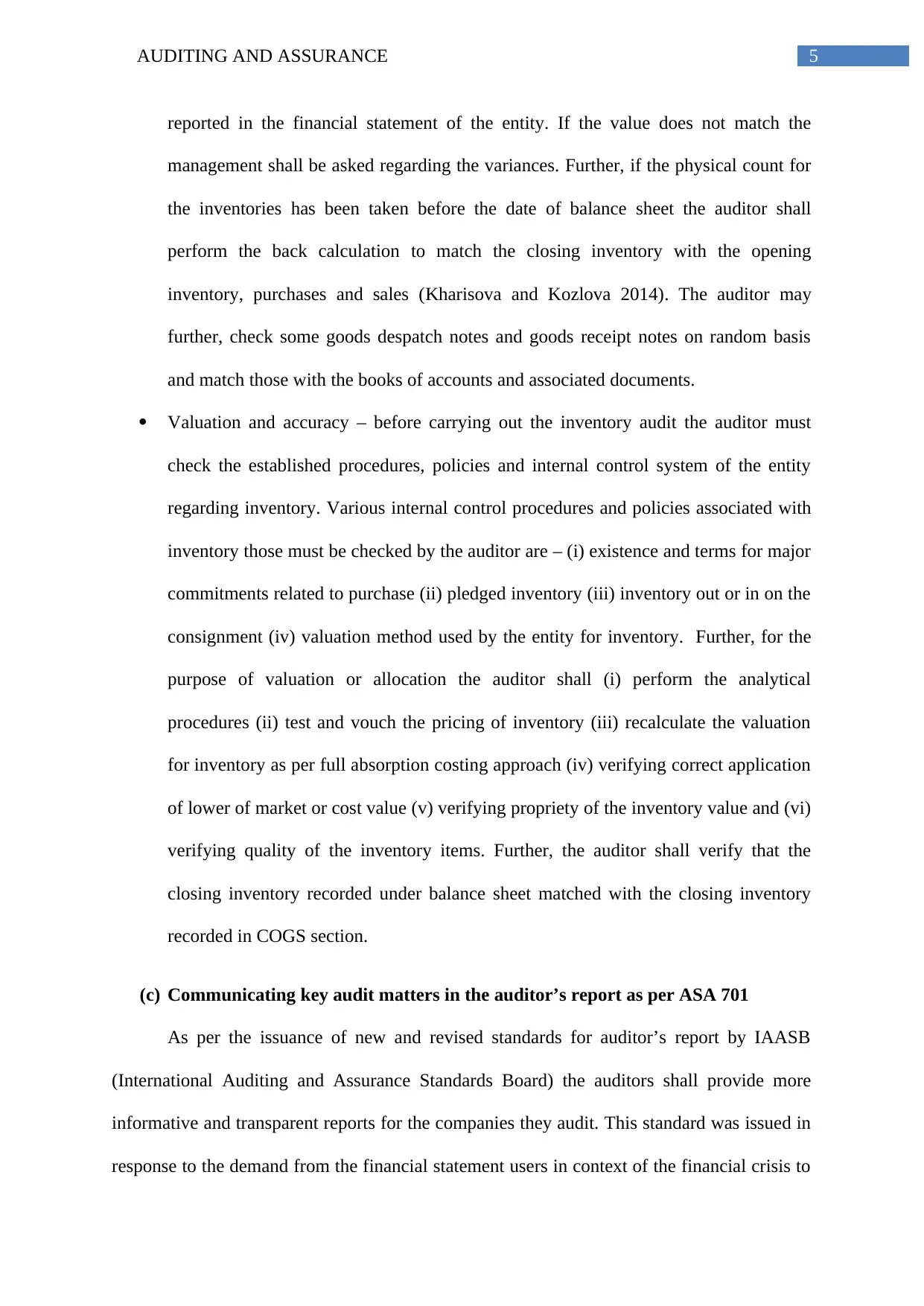
5AUDITING AND ASSURANCE
reported in the financial statement of the entity. If the value does not match the
management shall be asked regarding the variances. Further, if the physical count for
the inventories has been taken before the date of balance sheet the auditor shall
perform the back calculation to match the closing inventory with the opening
inventory, purchases and sales (Kharisova and Kozlova 2014). The auditor may
further, check some goods despatch notes and goods receipt notes on random basis
and match those with the books of accounts and associated documents.
Valuation and accuracy – before carrying out the inventory audit the auditor must
check the established procedures, policies and internal control system of the entity
regarding inventory. Various internal control procedures and policies associated with
inventory those must be checked by the auditor are – (i) existence and terms for major
commitments related to purchase (ii) pledged inventory (iii) inventory out or in on the
consignment (iv) valuation method used by the entity for inventory. Further, for the
purpose of valuation or allocation the auditor shall (i) perform the analytical
procedures (ii) test and vouch the pricing of inventory (iii) recalculate the valuation
for inventory as per full absorption costing approach (iv) verifying correct application
of lower of market or cost value (v) verifying propriety of the inventory value and (vi)
verifying quality of the inventory items. Further, the auditor shall verify that the
closing inventory recorded under balance sheet matched with the closing inventory
recorded in COGS section.
(c) Communicating key audit matters in the auditor’s report as per ASA 701
As per the issuance of new and revised standards for auditor’s report by IAASB
(International Auditing and Assurance Standards Board) the auditors shall provide more
informative and transparent reports for the companies they audit. This standard was issued in
response to the demand from the financial statement users in context of the financial crisis to
reported in the financial statement of the entity. If the value does not match the
management shall be asked regarding the variances. Further, if the physical count for
the inventories has been taken before the date of balance sheet the auditor shall
perform the back calculation to match the closing inventory with the opening
inventory, purchases and sales (Kharisova and Kozlova 2014). The auditor may
further, check some goods despatch notes and goods receipt notes on random basis
and match those with the books of accounts and associated documents.
Valuation and accuracy – before carrying out the inventory audit the auditor must
check the established procedures, policies and internal control system of the entity
regarding inventory. Various internal control procedures and policies associated with
inventory those must be checked by the auditor are – (i) existence and terms for major
commitments related to purchase (ii) pledged inventory (iii) inventory out or in on the
consignment (iv) valuation method used by the entity for inventory. Further, for the
purpose of valuation or allocation the auditor shall (i) perform the analytical
procedures (ii) test and vouch the pricing of inventory (iii) recalculate the valuation
for inventory as per full absorption costing approach (iv) verifying correct application
of lower of market or cost value (v) verifying propriety of the inventory value and (vi)
verifying quality of the inventory items. Further, the auditor shall verify that the
closing inventory recorded under balance sheet matched with the closing inventory
recorded in COGS section.
(c) Communicating key audit matters in the auditor’s report as per ASA 701
As per the issuance of new and revised standards for auditor’s report by IAASB
(International Auditing and Assurance Standards Board) the auditors shall provide more
informative and transparent reports for the companies they audit. This standard was issued in
response to the demand from the financial statement users in context of the financial crisis to
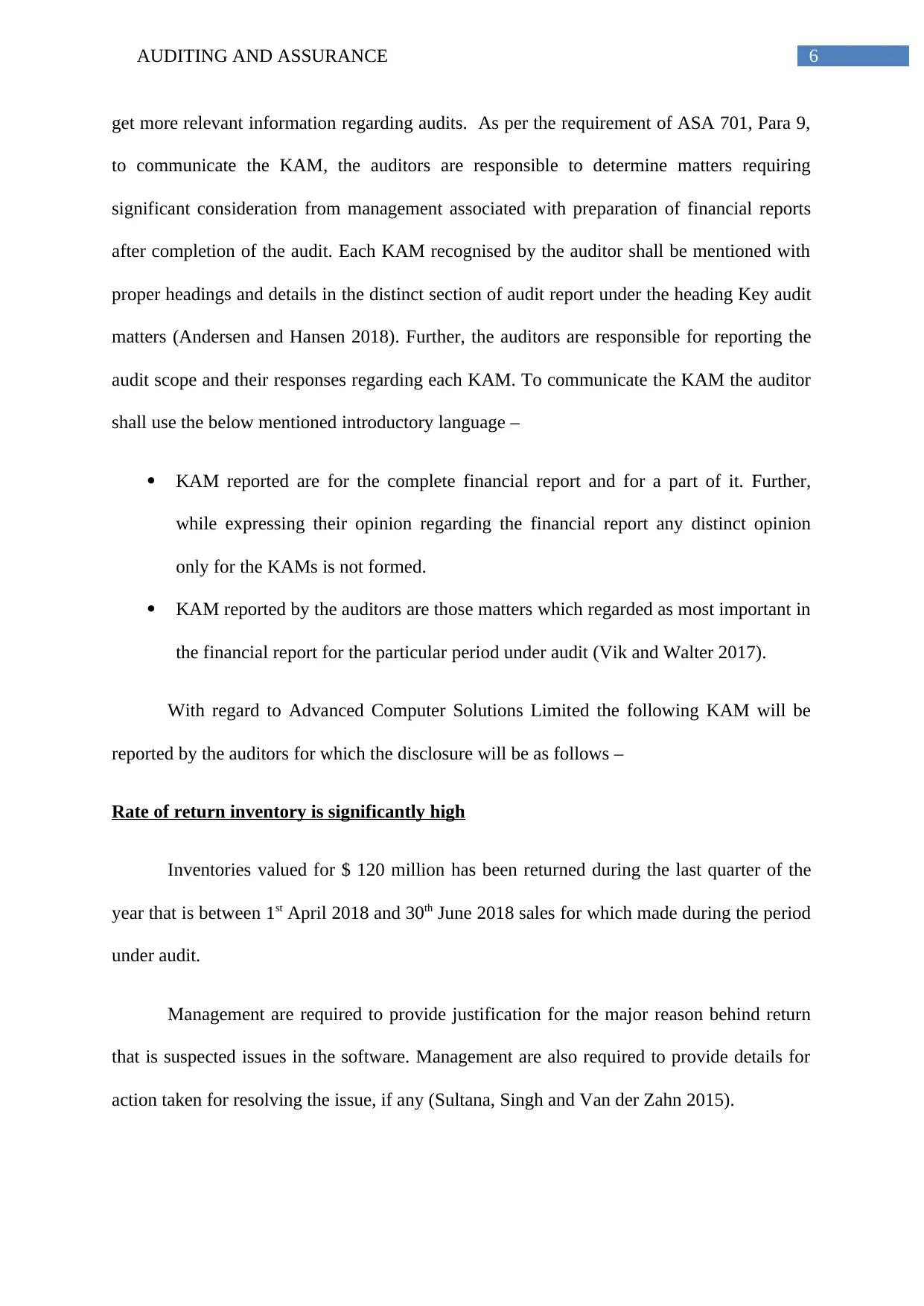
6AUDITING AND ASSURANCE
get more relevant information regarding audits. As per the requirement of ASA 701, Para 9,
to communicate the KAM, the auditors are responsible to determine matters requiring
significant consideration from management associated with preparation of financial reports
after completion of the audit. Each KAM recognised by the auditor shall be mentioned with
proper headings and details in the distinct section of audit report under the heading Key audit
matters (Andersen and Hansen 2018). Further, the auditors are responsible for reporting the
audit scope and their responses regarding each KAM. To communicate the KAM the auditor
shall use the below mentioned introductory language –
KAM reported are for the complete financial report and for a part of it. Further,
while expressing their opinion regarding the financial report any distinct opinion
only for the KAMs is not formed.
KAM reported by the auditors are those matters which regarded as most important in
the financial report for the particular period under audit (Vik and Walter 2017).
With regard to Advanced Computer Solutions Limited the following KAM will be
reported by the auditors for which the disclosure will be as follows –
Rate of return inventory is significantly high
Inventories valued for $ 120 million has been returned during the last quarter of the
year that is between 1st April 2018 and 30th June 2018 sales for which made during the period
under audit.
Management are required to provide justification for the major reason behind return
that is suspected issues in the software. Management are also required to provide details for
action taken for resolving the issue, if any (Sultana, Singh and Van der Zahn 2015).
get more relevant information regarding audits. As per the requirement of ASA 701, Para 9,
to communicate the KAM, the auditors are responsible to determine matters requiring
significant consideration from management associated with preparation of financial reports
after completion of the audit. Each KAM recognised by the auditor shall be mentioned with
proper headings and details in the distinct section of audit report under the heading Key audit
matters (Andersen and Hansen 2018). Further, the auditors are responsible for reporting the
audit scope and their responses regarding each KAM. To communicate the KAM the auditor
shall use the below mentioned introductory language –
KAM reported are for the complete financial report and for a part of it. Further,
while expressing their opinion regarding the financial report any distinct opinion
only for the KAMs is not formed.
KAM reported by the auditors are those matters which regarded as most important in
the financial report for the particular period under audit (Vik and Walter 2017).
With regard to Advanced Computer Solutions Limited the following KAM will be
reported by the auditors for which the disclosure will be as follows –
Rate of return inventory is significantly high
Inventories valued for $ 120 million has been returned during the last quarter of the
year that is between 1st April 2018 and 30th June 2018 sales for which made during the period
under audit.
Management are required to provide justification for the major reason behind return
that is suspected issues in the software. Management are also required to provide details for
action taken for resolving the issue, if any (Sultana, Singh and Van der Zahn 2015).
Paraphrase This Document
Need a fresh take? Get an instant paraphrase of this document with our AI Paraphraser
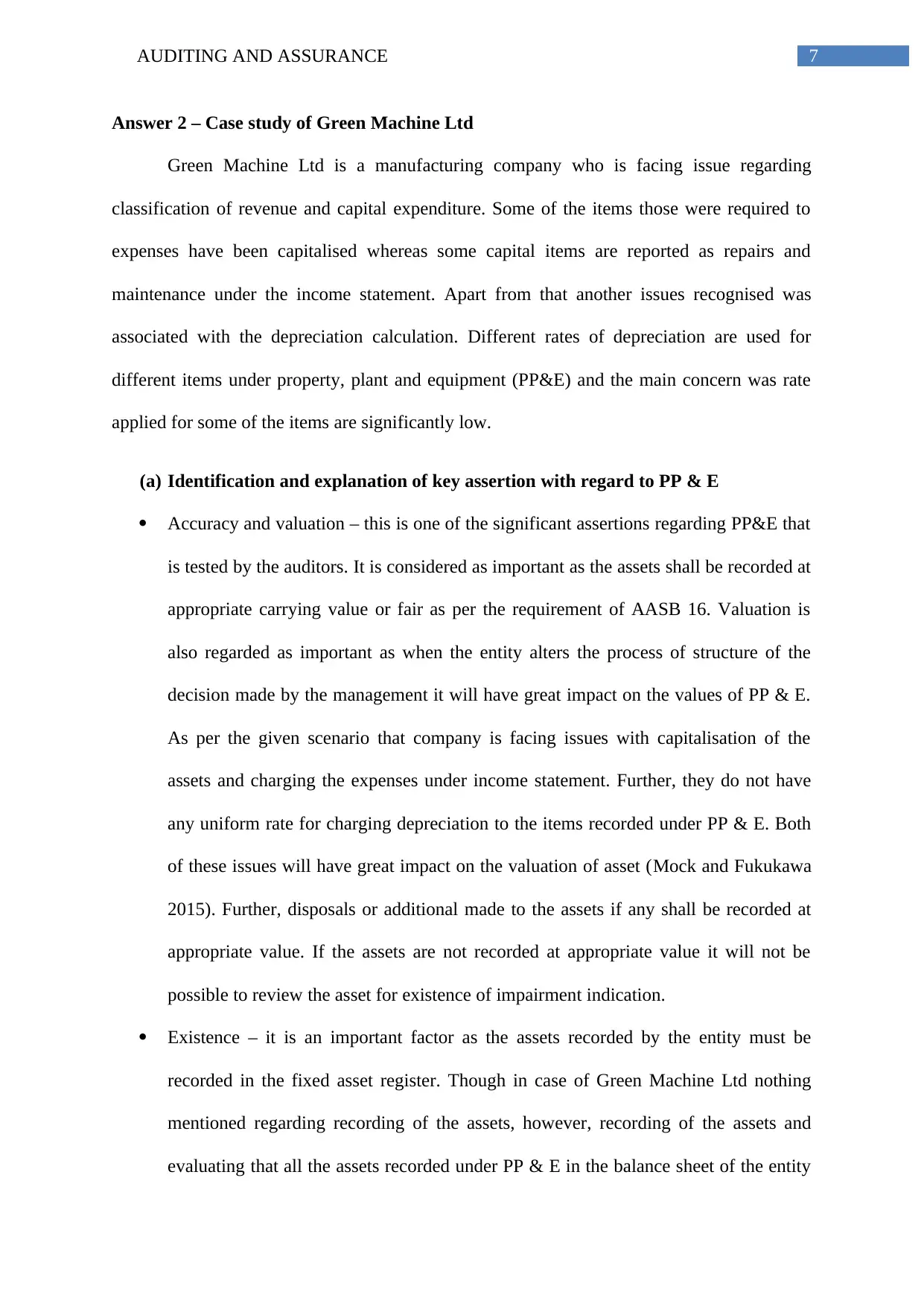
7AUDITING AND ASSURANCE
Answer 2 – Case study of Green Machine Ltd
Green Machine Ltd is a manufacturing company who is facing issue regarding
classification of revenue and capital expenditure. Some of the items those were required to
expenses have been capitalised whereas some capital items are reported as repairs and
maintenance under the income statement. Apart from that another issues recognised was
associated with the depreciation calculation. Different rates of depreciation are used for
different items under property, plant and equipment (PP&E) and the main concern was rate
applied for some of the items are significantly low.
(a) Identification and explanation of key assertion with regard to PP & E
Accuracy and valuation – this is one of the significant assertions regarding PP&E that
is tested by the auditors. It is considered as important as the assets shall be recorded at
appropriate carrying value or fair as per the requirement of AASB 16. Valuation is
also regarded as important as when the entity alters the process of structure of the
decision made by the management it will have great impact on the values of PP & E.
As per the given scenario that company is facing issues with capitalisation of the
assets and charging the expenses under income statement. Further, they do not have
any uniform rate for charging depreciation to the items recorded under PP & E. Both
of these issues will have great impact on the valuation of asset (Mock and Fukukawa
2015). Further, disposals or additional made to the assets if any shall be recorded at
appropriate value. If the assets are not recorded at appropriate value it will not be
possible to review the asset for existence of impairment indication.
Existence – it is an important factor as the assets recorded by the entity must be
recorded in the fixed asset register. Though in case of Green Machine Ltd nothing
mentioned regarding recording of the assets, however, recording of the assets and
evaluating that all the assets recorded under PP & E in the balance sheet of the entity
Answer 2 – Case study of Green Machine Ltd
Green Machine Ltd is a manufacturing company who is facing issue regarding
classification of revenue and capital expenditure. Some of the items those were required to
expenses have been capitalised whereas some capital items are reported as repairs and
maintenance under the income statement. Apart from that another issues recognised was
associated with the depreciation calculation. Different rates of depreciation are used for
different items under property, plant and equipment (PP&E) and the main concern was rate
applied for some of the items are significantly low.
(a) Identification and explanation of key assertion with regard to PP & E
Accuracy and valuation – this is one of the significant assertions regarding PP&E that
is tested by the auditors. It is considered as important as the assets shall be recorded at
appropriate carrying value or fair as per the requirement of AASB 16. Valuation is
also regarded as important as when the entity alters the process of structure of the
decision made by the management it will have great impact on the values of PP & E.
As per the given scenario that company is facing issues with capitalisation of the
assets and charging the expenses under income statement. Further, they do not have
any uniform rate for charging depreciation to the items recorded under PP & E. Both
of these issues will have great impact on the valuation of asset (Mock and Fukukawa
2015). Further, disposals or additional made to the assets if any shall be recorded at
appropriate value. If the assets are not recorded at appropriate value it will not be
possible to review the asset for existence of impairment indication.
Existence – it is an important factor as the assets recorded by the entity must be
recorded in the fixed asset register. Though in case of Green Machine Ltd nothing
mentioned regarding recording of the assets, however, recording of the assets and
evaluating that all the assets recorded under PP & E in the balance sheet of the entity
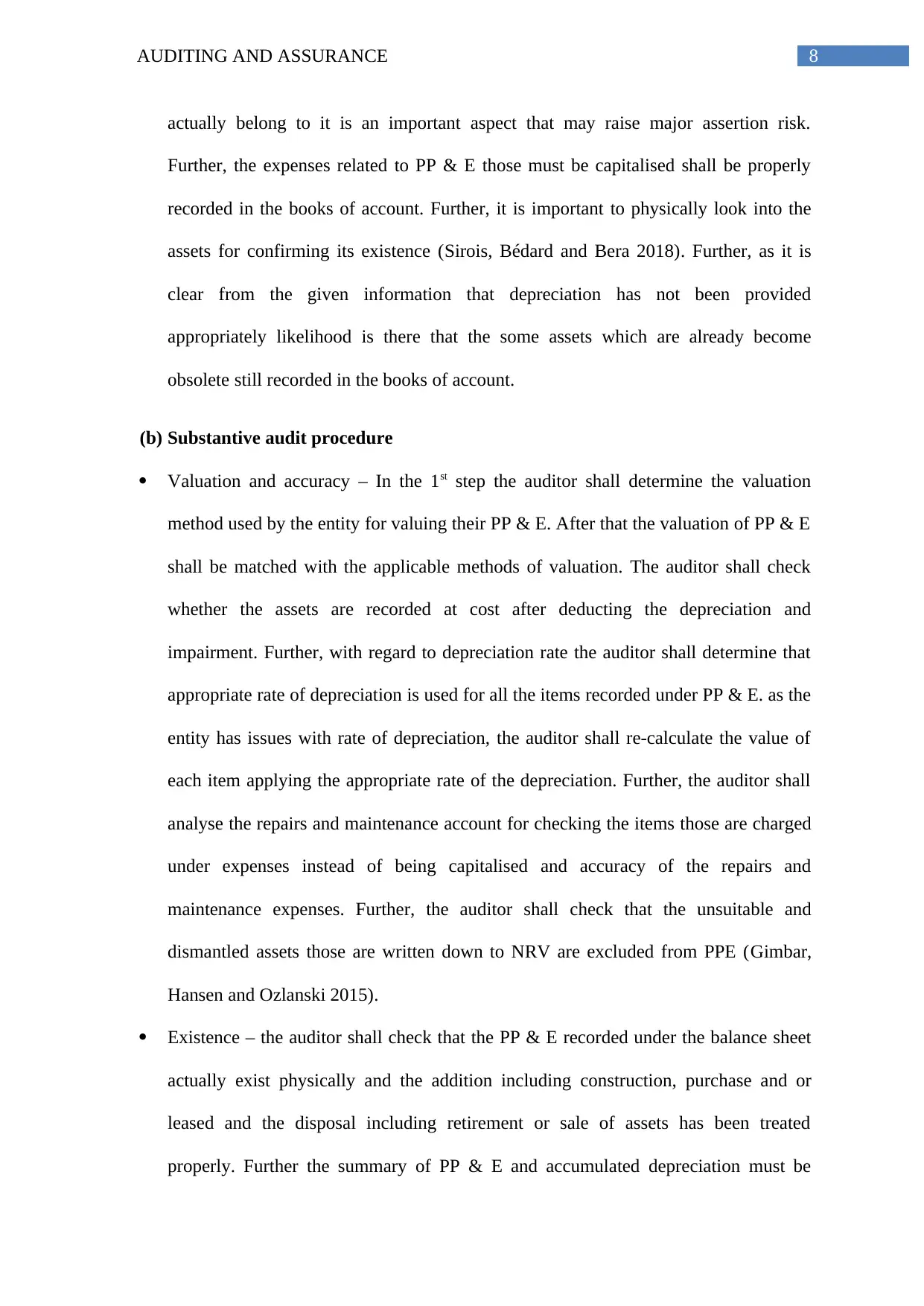
8AUDITING AND ASSURANCE
actually belong to it is an important aspect that may raise major assertion risk.
Further, the expenses related to PP & E those must be capitalised shall be properly
recorded in the books of account. Further, it is important to physically look into the
assets for confirming its existence (Sirois, Bédard and Bera 2018). Further, as it is
clear from the given information that depreciation has not been provided
appropriately likelihood is there that the some assets which are already become
obsolete still recorded in the books of account.
(b) Substantive audit procedure
Valuation and accuracy – In the 1st step the auditor shall determine the valuation
method used by the entity for valuing their PP & E. After that the valuation of PP & E
shall be matched with the applicable methods of valuation. The auditor shall check
whether the assets are recorded at cost after deducting the depreciation and
impairment. Further, with regard to depreciation rate the auditor shall determine that
appropriate rate of depreciation is used for all the items recorded under PP & E. as the
entity has issues with rate of depreciation, the auditor shall re-calculate the value of
each item applying the appropriate rate of the depreciation. Further, the auditor shall
analyse the repairs and maintenance account for checking the items those are charged
under expenses instead of being capitalised and accuracy of the repairs and
maintenance expenses. Further, the auditor shall check that the unsuitable and
dismantled assets those are written down to NRV are excluded from PPE (Gimbar,
Hansen and Ozlanski 2015).
Existence – the auditor shall check that the PP & E recorded under the balance sheet
actually exist physically and the addition including construction, purchase and or
leased and the disposal including retirement or sale of assets has been treated
properly. Further the summary of PP & E and accumulated depreciation must be
actually belong to it is an important aspect that may raise major assertion risk.
Further, the expenses related to PP & E those must be capitalised shall be properly
recorded in the books of account. Further, it is important to physically look into the
assets for confirming its existence (Sirois, Bédard and Bera 2018). Further, as it is
clear from the given information that depreciation has not been provided
appropriately likelihood is there that the some assets which are already become
obsolete still recorded in the books of account.
(b) Substantive audit procedure
Valuation and accuracy – In the 1st step the auditor shall determine the valuation
method used by the entity for valuing their PP & E. After that the valuation of PP & E
shall be matched with the applicable methods of valuation. The auditor shall check
whether the assets are recorded at cost after deducting the depreciation and
impairment. Further, with regard to depreciation rate the auditor shall determine that
appropriate rate of depreciation is used for all the items recorded under PP & E. as the
entity has issues with rate of depreciation, the auditor shall re-calculate the value of
each item applying the appropriate rate of the depreciation. Further, the auditor shall
analyse the repairs and maintenance account for checking the items those are charged
under expenses instead of being capitalised and accuracy of the repairs and
maintenance expenses. Further, the auditor shall check that the unsuitable and
dismantled assets those are written down to NRV are excluded from PPE (Gimbar,
Hansen and Ozlanski 2015).
Existence – the auditor shall check that the PP & E recorded under the balance sheet
actually exist physically and the addition including construction, purchase and or
leased and the disposal including retirement or sale of assets has been treated
properly. Further the summary of PP & E and accumulated depreciation must be
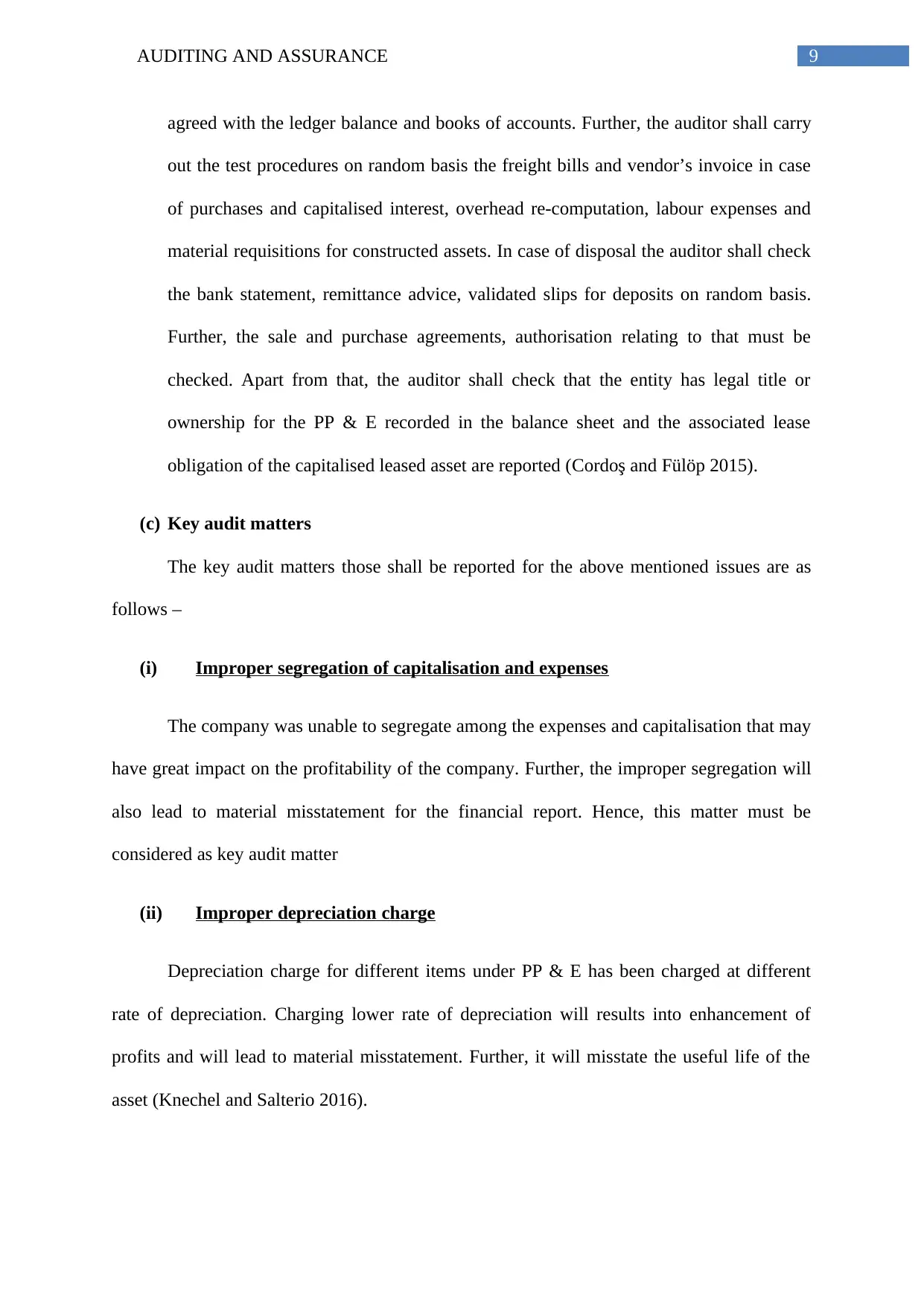
9AUDITING AND ASSURANCE
agreed with the ledger balance and books of accounts. Further, the auditor shall carry
out the test procedures on random basis the freight bills and vendor’s invoice in case
of purchases and capitalised interest, overhead re-computation, labour expenses and
material requisitions for constructed assets. In case of disposal the auditor shall check
the bank statement, remittance advice, validated slips for deposits on random basis.
Further, the sale and purchase agreements, authorisation relating to that must be
checked. Apart from that, the auditor shall check that the entity has legal title or
ownership for the PP & E recorded in the balance sheet and the associated lease
obligation of the capitalised leased asset are reported (Cordoş and Fülöp 2015).
(c) Key audit matters
The key audit matters those shall be reported for the above mentioned issues are as
follows –
(i) Improper segregation of capitalisation and expenses
The company was unable to segregate among the expenses and capitalisation that may
have great impact on the profitability of the company. Further, the improper segregation will
also lead to material misstatement for the financial report. Hence, this matter must be
considered as key audit matter
(ii) Improper depreciation charge
Depreciation charge for different items under PP & E has been charged at different
rate of depreciation. Charging lower rate of depreciation will results into enhancement of
profits and will lead to material misstatement. Further, it will misstate the useful life of the
asset (Knechel and Salterio 2016).
agreed with the ledger balance and books of accounts. Further, the auditor shall carry
out the test procedures on random basis the freight bills and vendor’s invoice in case
of purchases and capitalised interest, overhead re-computation, labour expenses and
material requisitions for constructed assets. In case of disposal the auditor shall check
the bank statement, remittance advice, validated slips for deposits on random basis.
Further, the sale and purchase agreements, authorisation relating to that must be
checked. Apart from that, the auditor shall check that the entity has legal title or
ownership for the PP & E recorded in the balance sheet and the associated lease
obligation of the capitalised leased asset are reported (Cordoş and Fülöp 2015).
(c) Key audit matters
The key audit matters those shall be reported for the above mentioned issues are as
follows –
(i) Improper segregation of capitalisation and expenses
The company was unable to segregate among the expenses and capitalisation that may
have great impact on the profitability of the company. Further, the improper segregation will
also lead to material misstatement for the financial report. Hence, this matter must be
considered as key audit matter
(ii) Improper depreciation charge
Depreciation charge for different items under PP & E has been charged at different
rate of depreciation. Charging lower rate of depreciation will results into enhancement of
profits and will lead to material misstatement. Further, it will misstate the useful life of the
asset (Knechel and Salterio 2016).
Secure Best Marks with AI Grader
Need help grading? Try our AI Grader for instant feedback on your assignments.
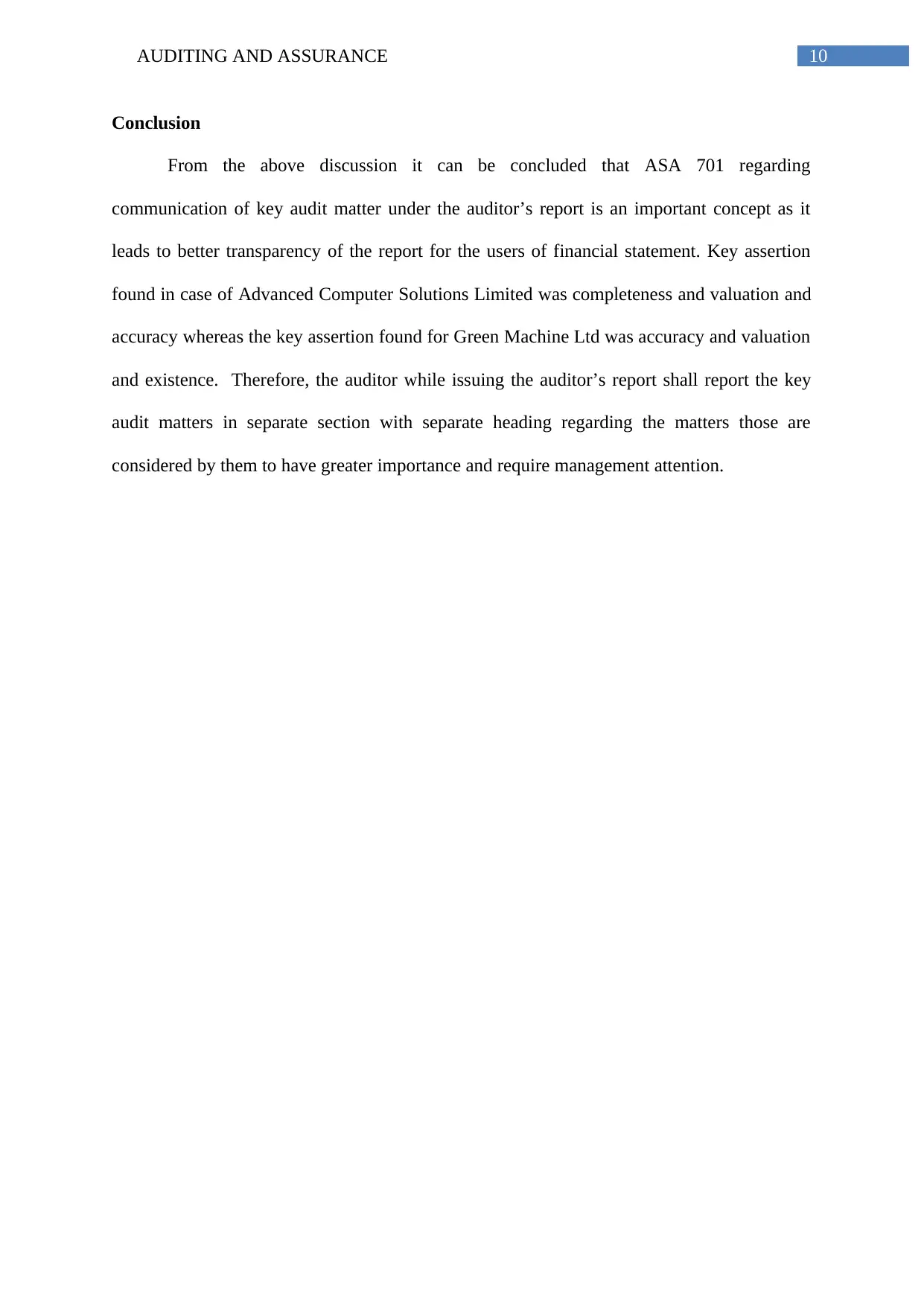
10AUDITING AND ASSURANCE
Conclusion
From the above discussion it can be concluded that ASA 701 regarding
communication of key audit matter under the auditor’s report is an important concept as it
leads to better transparency of the report for the users of financial statement. Key assertion
found in case of Advanced Computer Solutions Limited was completeness and valuation and
accuracy whereas the key assertion found for Green Machine Ltd was accuracy and valuation
and existence. Therefore, the auditor while issuing the auditor’s report shall report the key
audit matters in separate section with separate heading regarding the matters those are
considered by them to have greater importance and require management attention.
Conclusion
From the above discussion it can be concluded that ASA 701 regarding
communication of key audit matter under the auditor’s report is an important concept as it
leads to better transparency of the report for the users of financial statement. Key assertion
found in case of Advanced Computer Solutions Limited was completeness and valuation and
accuracy whereas the key assertion found for Green Machine Ltd was accuracy and valuation
and existence. Therefore, the auditor while issuing the auditor’s report shall report the key
audit matters in separate section with separate heading regarding the matters those are
considered by them to have greater importance and require management attention.
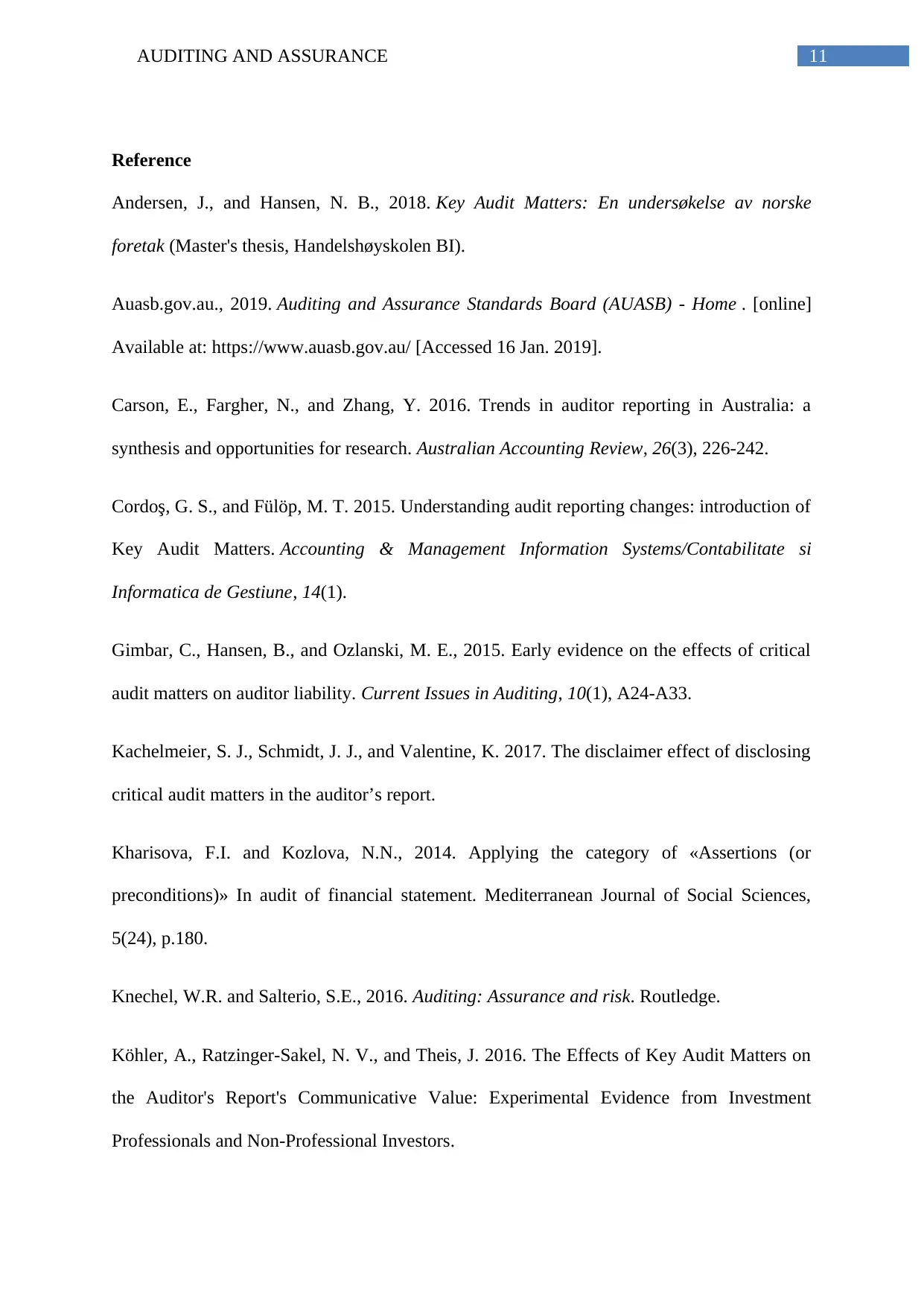
11AUDITING AND ASSURANCE
Reference
Andersen, J., and Hansen, N. B., 2018. Key Audit Matters: En undersøkelse av norske
foretak (Master's thesis, Handelshøyskolen BI).
Auasb.gov.au., 2019. Auditing and Assurance Standards Board (AUASB) - Home . [online]
Available at: https://www.auasb.gov.au/ [Accessed 16 Jan. 2019].
Carson, E., Fargher, N., and Zhang, Y. 2016. Trends in auditor reporting in Australia: a
synthesis and opportunities for research. Australian Accounting Review, 26(3), 226-242.
Cordoş, G. S., and Fülöp, M. T. 2015. Understanding audit reporting changes: introduction of
Key Audit Matters. Accounting & Management Information Systems/Contabilitate si
Informatica de Gestiune, 14(1).
Gimbar, C., Hansen, B., and Ozlanski, M. E., 2015. Early evidence on the effects of critical
audit matters on auditor liability. Current Issues in Auditing, 10(1), A24-A33.
Kachelmeier, S. J., Schmidt, J. J., and Valentine, K. 2017. The disclaimer effect of disclosing
critical audit matters in the auditor’s report.
Kharisova, F.I. and Kozlova, N.N., 2014. Applying the category of «Assertions (or
preconditions)» In audit of financial statement. Mediterranean Journal of Social Sciences,
5(24), p.180.
Knechel, W.R. and Salterio, S.E., 2016. Auditing: Assurance and risk. Routledge.
Köhler, A., Ratzinger-Sakel, N. V., and Theis, J. 2016. The Effects of Key Audit Matters on
the Auditor's Report's Communicative Value: Experimental Evidence from Investment
Professionals and Non-Professional Investors.
Reference
Andersen, J., and Hansen, N. B., 2018. Key Audit Matters: En undersøkelse av norske
foretak (Master's thesis, Handelshøyskolen BI).
Auasb.gov.au., 2019. Auditing and Assurance Standards Board (AUASB) - Home . [online]
Available at: https://www.auasb.gov.au/ [Accessed 16 Jan. 2019].
Carson, E., Fargher, N., and Zhang, Y. 2016. Trends in auditor reporting in Australia: a
synthesis and opportunities for research. Australian Accounting Review, 26(3), 226-242.
Cordoş, G. S., and Fülöp, M. T. 2015. Understanding audit reporting changes: introduction of
Key Audit Matters. Accounting & Management Information Systems/Contabilitate si
Informatica de Gestiune, 14(1).
Gimbar, C., Hansen, B., and Ozlanski, M. E., 2015. Early evidence on the effects of critical
audit matters on auditor liability. Current Issues in Auditing, 10(1), A24-A33.
Kachelmeier, S. J., Schmidt, J. J., and Valentine, K. 2017. The disclaimer effect of disclosing
critical audit matters in the auditor’s report.
Kharisova, F.I. and Kozlova, N.N., 2014. Applying the category of «Assertions (or
preconditions)» In audit of financial statement. Mediterranean Journal of Social Sciences,
5(24), p.180.
Knechel, W.R. and Salterio, S.E., 2016. Auditing: Assurance and risk. Routledge.
Köhler, A., Ratzinger-Sakel, N. V., and Theis, J. 2016. The Effects of Key Audit Matters on
the Auditor's Report's Communicative Value: Experimental Evidence from Investment
Professionals and Non-Professional Investors.
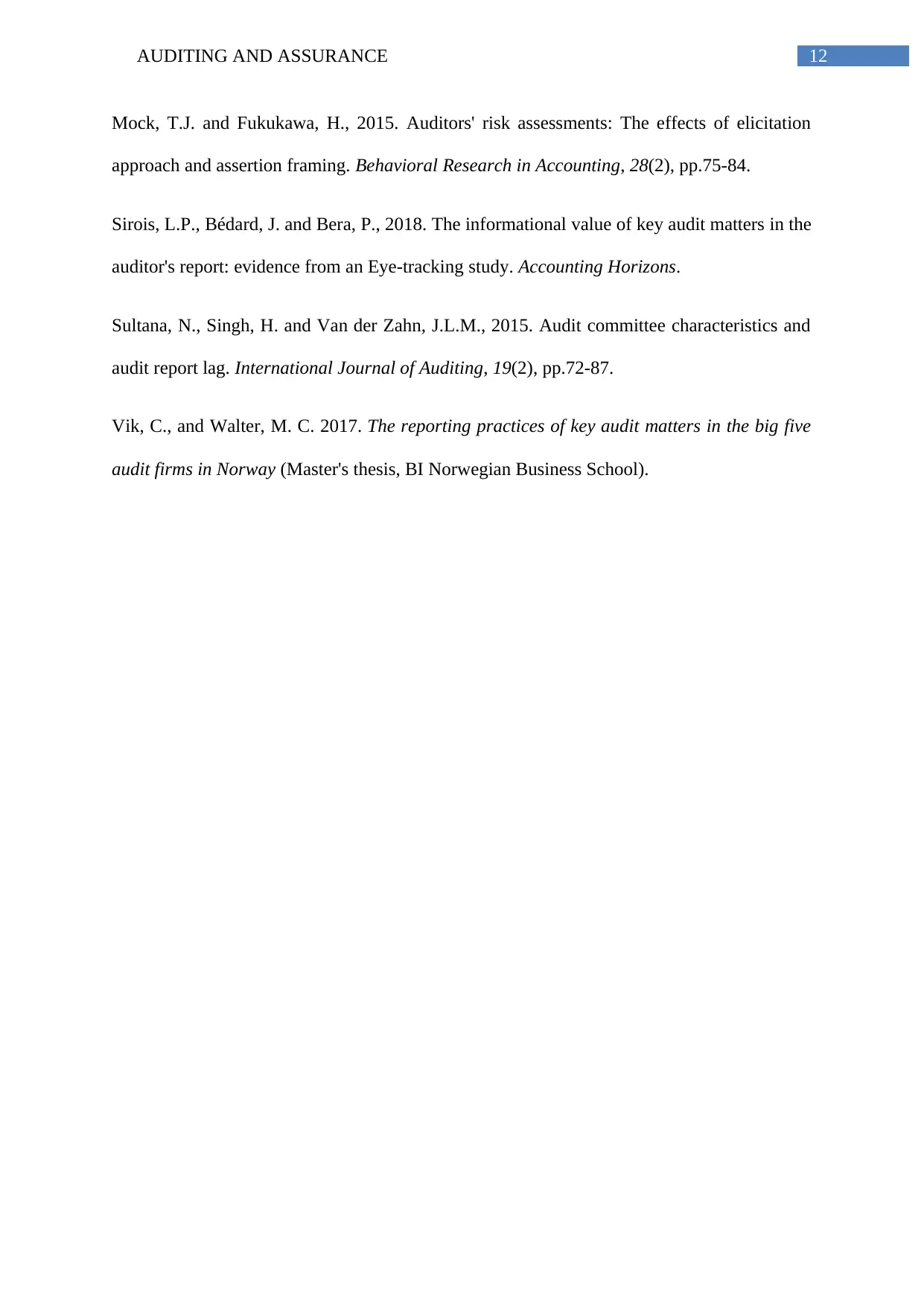
12AUDITING AND ASSURANCE
Mock, T.J. and Fukukawa, H., 2015. Auditors' risk assessments: The effects of elicitation
approach and assertion framing. Behavioral Research in Accounting, 28(2), pp.75-84.
Sirois, L.P., Bédard, J. and Bera, P., 2018. The informational value of key audit matters in the
auditor's report: evidence from an Eye-tracking study. Accounting Horizons.
Sultana, N., Singh, H. and Van der Zahn, J.L.M., 2015. Audit committee characteristics and
audit report lag. International Journal of Auditing, 19(2), pp.72-87.
Vik, C., and Walter, M. C. 2017. The reporting practices of key audit matters in the big five
audit firms in Norway (Master's thesis, BI Norwegian Business School).
Mock, T.J. and Fukukawa, H., 2015. Auditors' risk assessments: The effects of elicitation
approach and assertion framing. Behavioral Research in Accounting, 28(2), pp.75-84.
Sirois, L.P., Bédard, J. and Bera, P., 2018. The informational value of key audit matters in the
auditor's report: evidence from an Eye-tracking study. Accounting Horizons.
Sultana, N., Singh, H. and Van der Zahn, J.L.M., 2015. Audit committee characteristics and
audit report lag. International Journal of Auditing, 19(2), pp.72-87.
Vik, C., and Walter, M. C. 2017. The reporting practices of key audit matters in the big five
audit firms in Norway (Master's thesis, BI Norwegian Business School).
1 out of 13
Your All-in-One AI-Powered Toolkit for Academic Success.
+13062052269
info@desklib.com
Available 24*7 on WhatsApp / Email
![[object Object]](/_next/static/media/star-bottom.7253800d.svg)
Unlock your academic potential
© 2024 | Zucol Services PVT LTD | All rights reserved.





